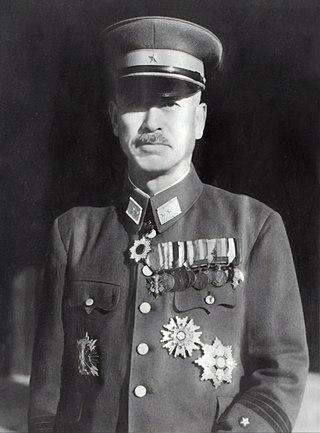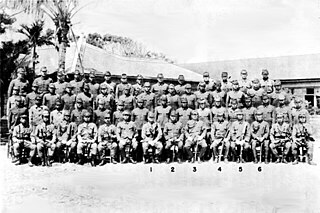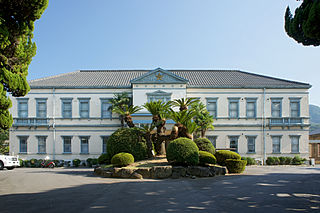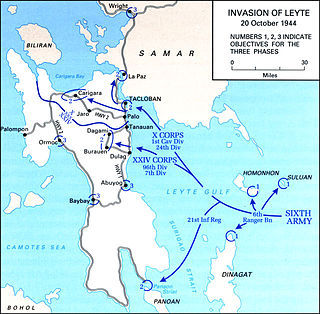
The Battle of Okinawa, codenamed Operation Iceberg, was a major battle of the Pacific War fought on the island of Okinawa by United States Army and United States Marine Corps forces against the Imperial Japanese Army. The initial invasion of Okinawa on 1 April 1945 was the largest amphibious assault in the Pacific Theater of World War II. The Kerama Islands surrounding Okinawa were preemptively captured on 26 March by the 77th Infantry Division. The 82-day battle lasted from 1 April until 22 June 1945. After a long campaign of island hopping, the Allies were planning to use Kadena Air Base on the large island of Okinawa as a base for Operation Downfall, the planned invasion of the Japanese home islands, 340 mi (550 km) away.

The I Corps is a corps of the United States Army headquartered in Joint Base Lewis-McChord, Washington. It is a major formation of United States Army Pacific (USARPAC) and its current mission involves administrative oversight of army units in the Asia-Pacific region, including the Pacific Pathways program.

Mitsuru Ushijima was a Japanese general who served during the Second Sino-Japanese War and World War II. He was the commanding general of the 32nd Army, which fought in the Battle of Okinawa during the final stages of the war. Ushijima's troops were defeated, and at the end of the battle he committed suicide.

Operation Downfall was the proposed Allied plan for the invasion of the Japanese home islands near the end of World War II.
The Southwestern Front was a front of the Red Army during the Second World War, formed thrice.

IX Corps was a corps of the United States Army. For most of its operational history, IX Corps was headquartered in or around Japan and subordinate to US Army commands in the Far East.

The Japanese 32nd Army was an army of the Imperial Japanese Army during the final stages of World War II. It was annihilated during the Battle of Okinawa.
Organization of the Kwantung Army which was an army group of the Imperial Japanese Army of Japan.
Organization of Japanese forces in the South-East Asian theatre of World War II.
The following is the order of battle of the forces involved in the Battle of Shanghai, during the opening stages of the Second Sino-Japanese War.

Isamu Chō was an officer in the Imperial Japanese Army known for his support of ultranationalist politics and involvement in a number of attempted coup d'états in pre-World War II Japan.
The 24th Division was an infantry division in the Imperial Japanese Army. Its callsign was the Mountain Division. The 24th Division was formed in Harbin, Manchukuo on 6 October 1939, as part of the Manchukuo territorial defense force under overall command of the 5th Army group of the Kwantung Army.

The 11th Division was an infantry division in the Imperial Japanese Army. Its tsūshōgō code name was the Brocade Division, and its military symbol was 11D. The 11th Division was one of six infantry divisions newly raised by the Imperial Japanese Army after the First Sino-Japanese War (1894–1895). The division received its colors on 1 October 1898 and was disbanded in September 1945. Its troops were recruited primarily from communities in the four prefectures of the island of Shikoku. It was originally headquartered in the city of Zentsuji, Kagawa, and its first commander was Lieutenant General Nogi Maresuke.

The Battle of Labuan was an engagement fought between Allied and Imperial Japanese forces on the island of Labuan off Borneo during June 1945. It formed part of the Australian invasion of North Borneo, and was initiated by the Allied forces as part of a plan to capture the Brunei Bay area and develop it into a base to support future offensives.
The 109th Division was an infantry division of the Imperial Japanese Army. Its call sign was the Courage Division. It was formed on 24 August 1937 in Kanazawa as a square division, simultaneously with the 108th division. The nucleus for the formation was the 9th division headquarters. It was subordinated from the beginning to the Japanese Northern China Area Army.
The 62nd Division was an infantry division of the Imperial Japanese Army. Its call sign was the Stone Division. It was formed on 1 May 1943 in Taiyuan, simultaneously with the 63rd Division as a security division. The nucleus for the formation was the 4th and a part of the 6th Independent Mixed Brigades. As a security division, it lacked an artillery regiment. The division was initially assigned to the 1st Army.

The American invasion of the island of Okinawa, codenamed Operation Iceberg, took place 1 April 1945. The Japanese military was determined to inflict a casualty rate so high that the U.S. government would choose not to invade the Japanese home islands. To this end, the southern portion of the island had been covered with the most extensive system of fortifications and fields of fire yet encountered in the Pacific War.

The 8th Bomber Division or 8th Air Division of the People's Liberation Army Air Force (PLAAF) is an air formation of the People's Republic of China (PRC). Today, the 8th Bomber Division is assigned to the Southern Theater Command and operates Xian H-6 bombers. The 8th Bomber Division, the first and longest-serving bomber unit in the PRC, has been deployed in the 1950–1953 Korean War, 1958 Second Taiwan Strait Crisis, 1959 Tibetan uprising, and today conducts deterrence patrols in the South China Sea.

On 20 October 1944, troops of the United States Sixth Army under the direct command of Lieutenant General Walter Krueger, invaded the Philippine island of Leyte. This operation was the beginning of General Douglas MacArthur's fulfillment of his promise in March 1942 to the Filipino people that he would liberate them from Japanese rule.











